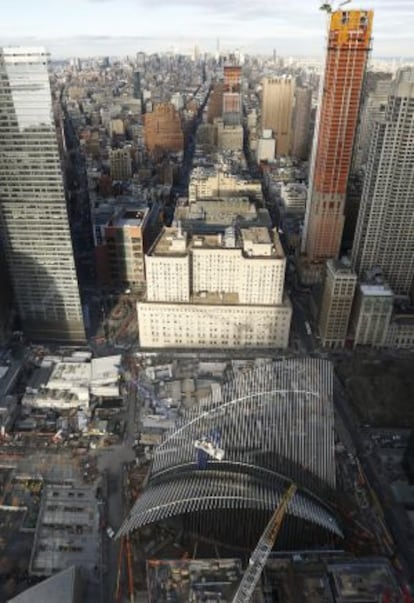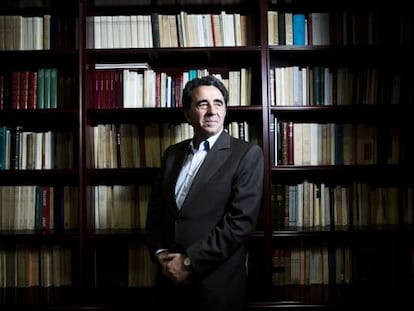Spanish architect’s “bird in flight” fails to take wing in New York
Santiago Calatrava's World Trade Center transport hub has been plagued by cost overruns

Whether seen from the 69th floor of the One World Trade Center or from the streets of Lower Manhattan, Spanish architect Santiago Calatrava’s proposed “bird in flight” transportation hub at Ground Zero has transformed into an example of wasteful public spending, bad management and ambitious political pride.
Six years behind schedule, the city’s largest new transport terminal is finally expected to be inaugurated later this year after costing $4 billion (€3.469 million) – double the original estimate.
The biggest attacks have been on the decision to install long protruding white steel spikes on the curved building that, according to New York Post columnist Steve Cuozzo, would make it look like a “stegosaurus” capable of terrorizing children and passers-by.
Even though the weight of the criticism has been leveled at Calatrava, an analysis of the cost overruns also puts public officials in charge of revitalizing the area in the spotlight.
The Port Authority of New York and New Jersey, which is controlled by both neighboring states and was responsible for rebuilding Ground Zero, now admits that it would not have approved the massive hub if it had known that the price was going to skyrocket.
Governor Pataki wanted to keep Staten Island’s Republican voters happy, which caused more overruns
“We would not today prioritize spending $3.7 billion on the transit hub over other significant infrastructure needs,” Patrick J. Foye, the Port Authority’s executive director, said in October.
What Foye didn’t say is that eight governors, around a dozen Port Authority executive directors and commissioners, and the odd mayor all tweaked the original plans in order to leave their mark.
The result has been astronomical expenditure on a station that is being used by about 46,000 passengers a day – just 10,000 more than those who pass through the much humbler 33rd Street PATH terminal, and much fewer than the 208,000 who use Grand Central Terminal. Estimates project around 160,000 passengers will use it a day in the future.
Christopher Ward, Port Authority executive director from 2008 to 2011, told The Wall Street Journal last year that no one said ‘no’ to the requests by the different agencies and officials “because it concerned the rebuilding of a place destroyed by terrorists.” During his first year as Authority chief, Ward declined to make around $500 million in cuts.
George E. Pataki, then the Republican governor of New York and a strong backer of the project, saw the majestic commuter hub as a massive feather in his cap as he set his sights on his unsuccessful presidential run. He had promised that the project would be completed by 2009.
“It will be symbolic for New York”
Santiago Calatrava has no doubts about his project. “It will be a New York landmark and a meeting point for residents and tourists. It is going to be positively surprising,” the Spanish architect said in an email to EL PAÍS.
In response to the avalanche of criticism, Calatrava said he accepted it because it was a complex project. “It is very complicated because of its location and the existing social sensibility. It connects various transport systems, which makes planning difficult. After the terrorist attacks in London and Madrid, authorities wanted changes to ensure they were following new requirements. That is why the costs were adjusted.”
Addressing the time delays, the architect said his project had to adapt to “unforeseen circumstances and new requirements.” He explained that spending for other adjacent projects was also included in the budget.
“It is a very fine result, especially the steel structure – the only one of its kind in the world. The stations will converge with other iconic landmarks in the city, such as the Hudson and East River bridges. I am proud to have participated in such a symbolic project.”
Others were also lured by the $4.5 billion in federal aid to revitalize Lower Manhattan.
The original project was estimated at $2 billion, with $300 million coming from the Port Authority and $1.2 billion in federal money. In 2008, the budget soared to $3.4 billion, including $655 million in administrative costs.
One of the political controversies that plagued the project was the need to keep open an important subway line crossing the area that is used daily by many Staten Island residents, a Republican stronghold, throughout construction. That decision cost $400 million and caused delays, but Pataki supported the move.
In 2005, the Police Department determined that changes were required for security reasons: the support structure for Calatrava’s planned wings needed to be reinforced. Around 36,500 tons of extra material was ordered at a cost of $474 million. The links to nearby infrastructure also cost more than expected, tacking on an additional $400 million.
Originally, the plans called for a retractable roof for the station, but that idea was dropped in 2008 because of the high costs involved. That same year, Mayor Michael Bloomberg ordered the 9/11 Memorial, located next to the station, to be made ready in time for the 10th anniversary of the World Trade Center attacks. Then came Hurricane Sandy in 2012, which also generated more overruns.
According to the New York press, Calatrava’s firm has received around $80 million.
“What happened to the ‘bird in flight’ we were promised?” asked Cuozzo in his column last August. “Or do the wings, not plastic but steel, suggest teeth whittled down by a sadistic dentist? Or a giant fishbone? The Hub exhausts your capacity for cheap jokes.”
At the moment no one is laughing.
Correction
The original version of this story incorrectly stated that there is a subway line connecting Manhattan with Staten Island. The line in question is in Manhattan only, but used daily by many Staten Island residents.
Tu suscripción se está usando en otro dispositivo
¿Quieres añadir otro usuario a tu suscripción?
Si continúas leyendo en este dispositivo, no se podrá leer en el otro.
FlechaTu suscripción se está usando en otro dispositivo y solo puedes acceder a EL PAÍS desde un dispositivo a la vez.
Si quieres compartir tu cuenta, cambia tu suscripción a la modalidad Premium, así podrás añadir otro usuario. Cada uno accederá con su propia cuenta de email, lo que os permitirá personalizar vuestra experiencia en EL PAÍS.
En el caso de no saber quién está usando tu cuenta, te recomendamos cambiar tu contraseña aquí.
Si decides continuar compartiendo tu cuenta, este mensaje se mostrará en tu dispositivo y en el de la otra persona que está usando tu cuenta de forma indefinida, afectando a tu experiencia de lectura. Puedes consultar aquí los términos y condiciones de la suscripción digital.









































